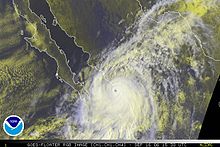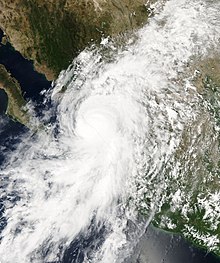Hurricane Lane (2006)
 Hurricane Lane at peak intensity as a Category 3 hurricane, on September 16 | |
| Meteorological history | |
|---|---|
| Formed | September 13, 2006 |
| Dissipated | September 17, 2006 |
| Category 3 major hurricane | |
| 1-minute sustained (SSHWS/NWS) | |
| Highest winds | 125 mph (205 km/h) |
| Lowest pressure | 952 mbar (hPa); 28.11 inHg |
| Overall effects | |
| Fatalities | 4 direct |
| Damage | $203 million (2006 USD) |
| Areas affected | Western Mexico, Southwestern United States |
| IBTrACS | |
Part of the 2006 Pacific hurricane season | |
Hurricane Lane was a strong
Throughout its path, Lane resulted in four deaths and moderate damage. Damage was heaviest in Sinaloa, where the hurricane made landfall, including reports of severe crop damage. Across Mexico, an estimated 4,320 homes were affected by the hurricane, with about 248,000 people affected. Moderate flooding was reported in Acapulco, resulting in mudslides in some areas. Damage across the country totaled $2.2 billion (2006 MXN), or $206 million (2006 USD, or $218 million in 2010 USD).
Meteorological history

Tropical storm (39–73 mph, 63–118 km/h)
Category 1 (74–95 mph, 119–153 km/h)
Category 2 (96–110 mph, 154–177 km/h)
Category 3 (111–129 mph, 178–208 km/h)
Category 4 (130–156 mph, 209–251 km/h)
Category 5 (≥157 mph, ≥252 km/h)
Unknown
A

Lane continued to become better organized, with deep convection developing into a
Hurricane Lane continued to organize with its 9-mile (14 km) wide eye, surrounded by very deep convection, and the storm strengthened further to reach peak winds of 125 mph (201 km/h) by midday on September 16.
Preparations
Due to Lane's projected path near the western coast of Mexico, authorities closed ports to small boats in the cities of
As Lane came closer to the coastline, all the
Prior to entering the area, the U.S. National Weather Service issued a Flood Watch for large portions of Texas due to the remnants of Lane.[19]
Impact

In Acapulco, the storm produced strong waves and heavy rain, leaving coastal streets with up to 16 inches (410 mm) of water. The heavy rainfall flooded 200 houses and caused a mudslide, resulting in the death of a seven-year-old boy. Flooding also occurred at the airport in Acapulco, though service was not interrupted. Offshore, strong waves capsized a boat, leaving one person missing. Heavy rainfall in the port of Lázaro Cárdenas, Michoacán, overflowed a canal, forcing over 500 people to evacuate their homes.[21] 500 acres (2.0 km2) of crops were destroyed by Lane in Michoacán. Road and airport damage in Colima totaled to about $30 million (2006 MXN, $2.7 million 2006 USD).[22] In Cajón de Peña, Jalisco, rainfall totaled to 7.36 inches (187 mm).[26] One man died in Pueblos Unidos after being knocked over by strong winds.[27] Throughout Jalisco, 109 people had to evacuate their homes due to landslides and heavy rainfall.[28]
In
Throughout Mexico, Hurricane Lane killed four people.[30] An estimated 4,320 homes were affected by the hurricane, with about 248,000 people affected. Water systems were damaged in nine municipalities, leaving thousands temporarily without water. A total of 19,200 miles (30,900 km) of roads and highways were damaged to some degree, including some destroyed bridges. In all, the hurricane caused about $2.2 billion (2006 MXN, $203 million 2006 USD) in damage in the country.[24] In the United States, the remnants of Lane brought precipitation to southern Texas.[32]
Aftermath
By the day after Hurricane Lane made landfall, most of the evacuated people returned to their homes to begin the cleanup process. Some tourists who remained in the area for the storm continued their vacations, while others tried to leave the area.[33] The federal government declared a state of emergency for nine municipalities in Sinaloa, allowing emergency funds to give relief support to the affected population.[22] Helicopters were used to distribute foods and locate cut-off residents. The government set up three temporary shelters in Mazatlán for 360 people and three shelters in Culiacán for about 1,000 affected residents.[30] To prevent the spread of Dengue fever, officials sent epidemiologists to 67 communities, with 18 mobile units and 15 Nebulizer units. By a month after the storm, all roads and highways affected by the hurricane were open for transportation.[24]
See also
- Other tropical cyclones named Lane
- Timeline of the 2006 Pacific hurricane season
References
- ^ Richard Knabb (2006). "Hurricane Lane Tropical Cyclone Report" (PDF). National Hurricane Center. Retrieved 2006-11-30.
- ^ Cobb/Pasch (2006). "September 12 Tropical Weather Outlook". National Hurricane Center. Retrieved 2006-09-15.[permanent dead link]
- ^ Aguirre/Avila (2006). "September 11 Tropical Weather Outlook". National Hurricane Center. Retrieved 2006-09-15.[permanent dead link]
- ^ Aguirre/Avila (2006). "September 12 Tropical Weather Outlook (2)". National Hurricane Center. Retrieved 2006-09-15.[permanent dead link]
- ^ Blake/Beven (2006). "Tropical Depression Thirteen-E Discussion One". National Hurricane Center. Retrieved 2006-09-15.
- ^ Rhome/Knabb (2006). "Tropical Storm Lane Discussion Three". National Hurricane Center. Retrieved 2006-09-15.
- ^ Beven (2006). "Tropical Storm Lane Discussion Four". National Hurricane Center. Retrieved 2006-09-15.
- ^ Franklin (2006). "Tropical Storm Lane Discussion Five". National Hurricane Center. Retrieved 2006-09-15.
- ^ Rhome/Knabb (2006). "Tropical Storm Lane Discussion Seven". National Hurricane Center. Retrieved 2006-09-15.
- ^ Beven (2006). "Hurricane Lane Discussion Nine". National Hurricane Center. Retrieved 2006-09-15.
- ^ Roberts/Stewart (2006). "Hurricane Lane Discussion Ten". National Hurricane Center. Retrieved 2006-09-15.
- ^ Rhome/Knabb (2006). "Hurricane Lane Discussion Eleven". National Hurricane Center. Retrieved 2006-09-16.
- ^ Beven (2006). "Hurricane Lane Discussion 12". National Hurricane Center. Retrieved 2006-09-16.
- ^ Beven (2006). "Hurricane Lane Update". National Hurricane Center. Retrieved 2006-09-16.
- ^ a b c Will Weissert (2006). "Lane weakens after lashing Mexico coast". Associated Press. Retrieved 2006-09-16.
- ^ Hurricane Research Division (2010-03-01). "Hurricane Data for Pacific Hurricanes 1949–2009". National Oceanic and Atmospheric Administration. Archived from the original on March 9, 2010. Retrieved 2010-03-01.
- ^ Roberts/Stewart (2006). "Hurricane Lane Discussion Fourteen". National Hurricane Center. Retrieved 2006-09-17.
- ^ Avila (2006). "Tropical Depression Lane Discussion Sixteen". National Hurricane Center. Retrieved 2006-09-17.
- ^ a b Fortbendnow.com (2006). "Fort Bend Under Flood Watch as Storm System Blankets The Region". Archived from the original on 2007-09-27. Retrieved 2006-09-18.
- ^ "Tropical Storm Lane lashes Mexico's Pacific coast". NBC News. Associated Press. 2006. Retrieved 2006-09-15.
- ^ a b Will Weissert (2006). "Hurricane Lane Heading Toward Baja". AP. Retrieved 2006-09-15.
- ^ a b c United Nations Office for the Coordination of Humanitarian Affairs (2006). "Mexico: Hurricane Lane OCHA Situation Report No. 1". Archived from the original on 2006-09-25. Retrieved 2006-09-23.
- ^ Servicio Meteorológico Nacional (Mexico) (2006). "El huracan 'Lane' crece en la costa oeste del país" (in Spanish). Archived from the original on December 15, 2006. Retrieved 2007-09-06.
- ^ a b c Coordinación General de Asesoria y Políticas Públicas Gobierno del Estato (2006). "Sociedad y gobierno unidos ante los daños del Huracán Lane" (in Spanish). Retrieved 2007-09-05.
- ^ Staff writer (September 16, 2006). "Toca tierra el ojo del huracán 'Lane'" (in Spanish). Notimex. Archived from the original on March 27, 2007. Retrieved 2006-09-16.
- ^ Beven (2006). "Hurricane Lane Public Advisory 12A". National Hurricane Center. Retrieved 2006-09-16.
- ^ a b c Tomas Sarmiento (2006). "Hurricane Lane leaves destruction in Mexico". Reuters. Archived from the original on 2006-09-20. Retrieved 2006-09-17.
- ^ Margot Habiby (2006-09-15). "Lane Strengthens to Hurricane on Approach to Mexico". Bloomberg.com. Archived from the original on 2007-09-30. Retrieved 2006-09-15.
- ^ AP (2006-09-17). "Hurricane Lane hits Mexico coast". BBC News. Retrieved 2006-09-18.
- ^ a b c United Nations Office for the Coordination of Humanitarian Affairs (2006). "Mexico: Hurricane Lane OCHA Situation Report No. 2". Archived from the original on 2007-09-27. Retrieved 2006-09-23.
- ^ Valdez Cardenas, Javier; Leon, Raymundo (2006-09-24). "En Sinaloa, los daños por Lane suman 1,200 millones de pesos". La Jornada (in Spanish). Retrieved 2006-10-03.
- ^ National Hurricane Center (2006). "2006 Tropical Weather Summary". Retrieved 2008-01-12.
- ^ Will Weissert (1994). "Cleaning up, clearing out after Lane". AP. Archived from the original on 2012-10-10. Retrieved 2006-09-18.
External links
- The NHC's archive on Hurricane Lane.
